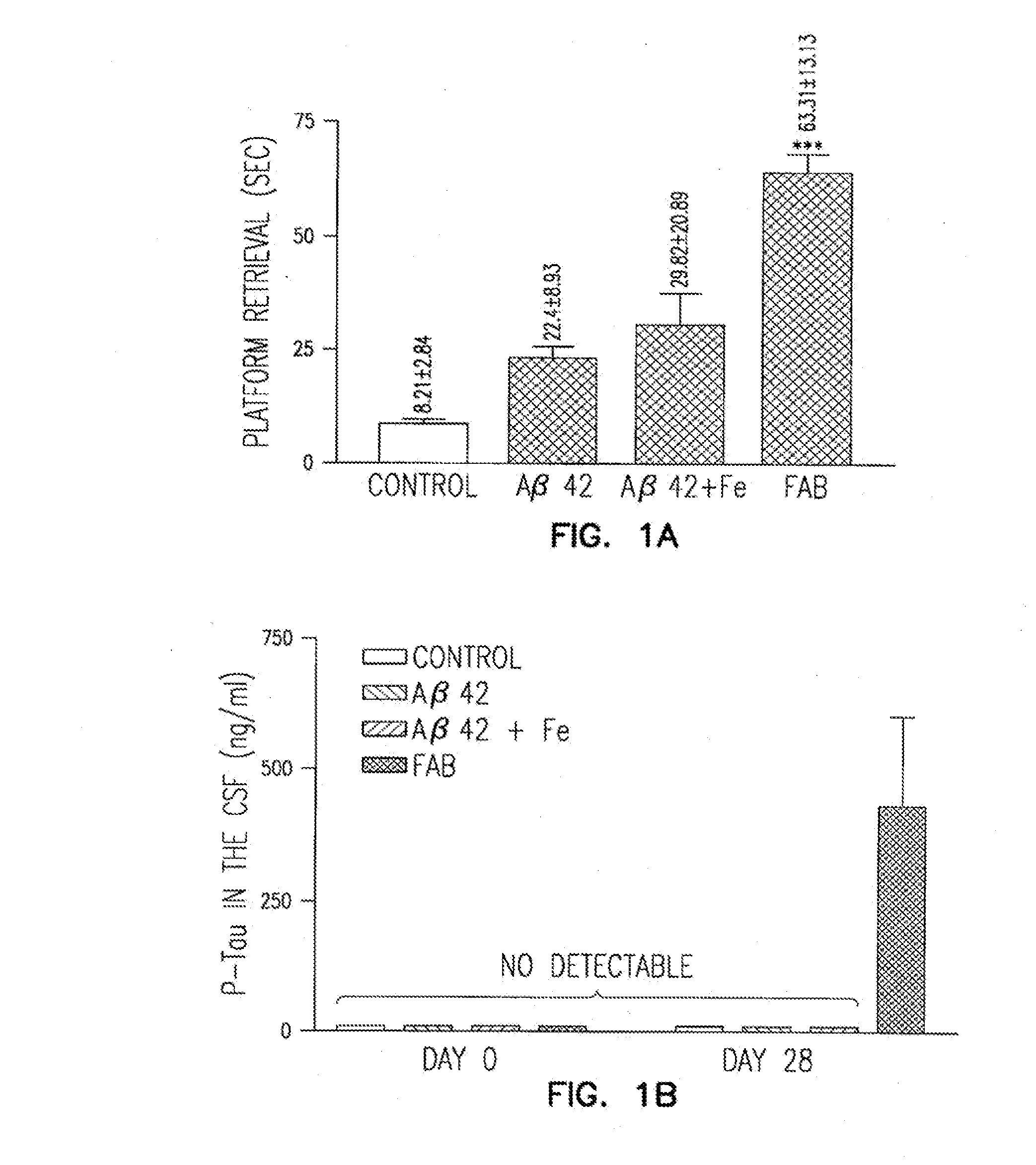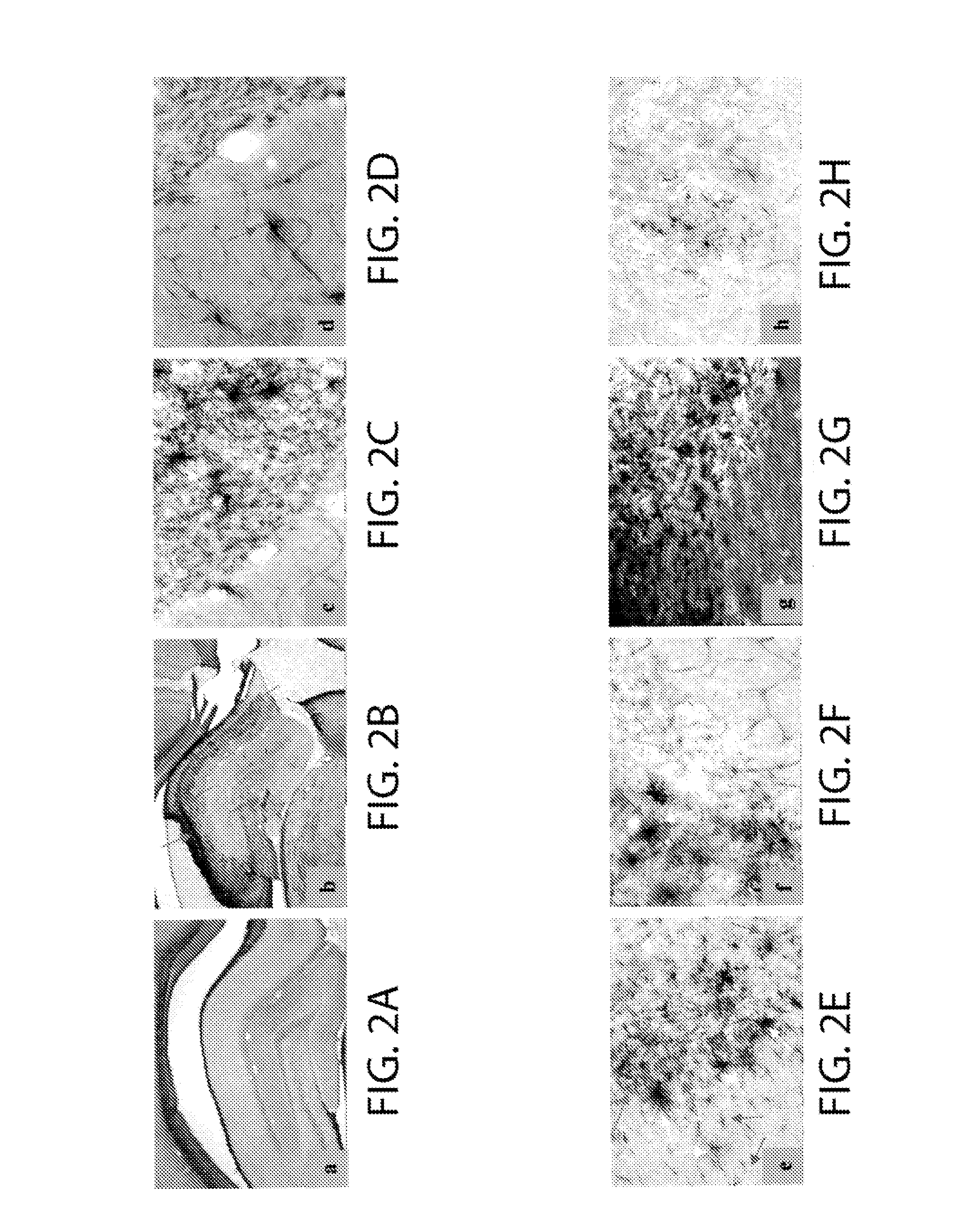Animal model simulating neurologic disease
a neurologic disease and animal model technology, applied in the field of animal models simulating neurologic disease, can solve the problems of not reflecting the pathophysiology, unable to understand the origin and progression of ad, and the reliability of behavior data must still be questioned
- Summary
- Abstract
- Description
- Claims
- Application Information
AI Technical Summary
Benefits of technology
Problems solved by technology
Method used
Image
Examples
example i
Inducing a Neurologic Disease in a Non-Human Animal
[0038]Animals: Long-Evans male rats weighing 300-325 grams were housed following a natural day-night cycle with food and water ad libitum.
[0039]Morris watermaze protocol: Before the surgery, the rats were trained on a standard Morris spatial navigation task in a black water tank (200 cm diameter). The water was rendered opaque by water-miscible non-toxic white paint (Crayola Inc.). The rats were placed in four different, randomly assigned, start positions and trained to find an invisible platform (20 cm diameter) at a fixed position in the middle of the water tank. The water temperature was about 24° C. A trial lasted until a rat found the platform or until 120 seconds elapsed. If a rat did not find the platform within 120 seconds, it was placed on the platform for 20 seconds and then removed from the water tank. Rats were trained for four consecutive days, four trials a day, with 30 minutes between subsequent trials. Surgery proce...
example 2
Testing for Drugs That Prevent Neurologic Disease
[0055]The animals of the present invention may be used to test compounds for the ability to confer protection against the development of neurologic disease, such as AD. An animal exhibiting a neurologic disease is treated with a test compound in parallel with an untreated control animal exhibiting the neurologic disease. A comparatively lower incidence of the neurologic disease in the treated animal is detected as an indication of protection. Treated and untreated animals are analyzed for diminished learning / exploratory / locomotor behavior (CI test), as well as diminished 2-deoxyglucose uptake / utilization, neuronal death, cholinergic neurotransmission impairment, neuritic plaques, NFT formation and hypertrophic gliosis in the cortico-limbic structures of the brain. To determine if a treatment can prevent or delay the onset of disease, half of the animals, for example mice, in a litter from a line of mice known to develop neurologic il...
example 3
Testing for Drugs That Treat Neurologic Disease
[0058]The animals of the present invention may be used to test compounds for the ability to improve or cure neurologic disease. An animal exhibiting the neurologic disease is treated with a test material in parallel with an untreated control animal exhibiting the neurologic disease. A comparatively delayed death, or an improvement in the neurobehavioral, pathologic, or functional indications of the disease is detected as an indication of protection. Treated and untreated animals are analyzed for diminished learning / exploratory / locomotor behavior, as well as diminished 2-deoxyglucose uptake / utilization, neuronal death, cholinergic neurotransmission impairment, neuritic plaques, NFT formation and hypertrophic gliosis in the cortico-limbic structures of the brain.
[0059]As demonstrated by the above results, the pre-clinical and pathologic findings in non-human FAB mammals show an unexpected, but striking parallel to those in humans with ne...
PUM
| Property | Measurement | Unit |
|---|---|---|
| time | aaaaa | aaaaa |
| diameter | aaaaa | aaaaa |
| diameter | aaaaa | aaaaa |
Abstract
Description
Claims
Application Information
 Login to View More
Login to View More - R&D
- Intellectual Property
- Life Sciences
- Materials
- Tech Scout
- Unparalleled Data Quality
- Higher Quality Content
- 60% Fewer Hallucinations
Browse by: Latest US Patents, China's latest patents, Technical Efficacy Thesaurus, Application Domain, Technology Topic, Popular Technical Reports.
© 2025 PatSnap. All rights reserved.Legal|Privacy policy|Modern Slavery Act Transparency Statement|Sitemap|About US| Contact US: help@patsnap.com



